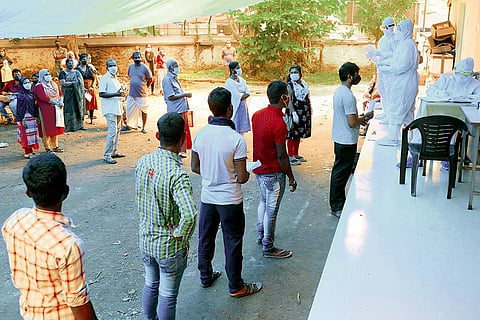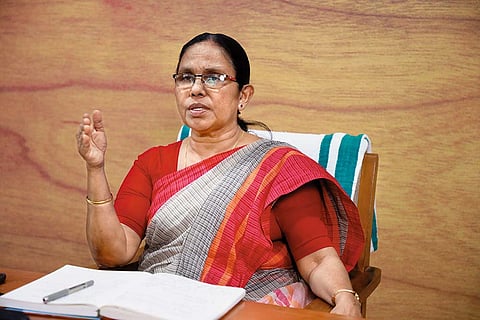Subin Dominic has been sifting through every local newspaper for an update on the reopening of the local market, where he owns a shop. Situated in the bustling Aluva market in Ernakulam, his shop was closed for more than a week and he is eagerly awaiting an announcement from the municipality about the reopening. Dominic runs a wholesale fish business, which he took over from his father 30 years ago. The lifting of lockdown restrictions hasn’t brought him any relief. His business has shrunk by half in the past six months and bank debts are mounting. “It will take a few years to recover from the losses. I have never faced such a situation before,” says Dominic.
In The Red Zone
As Covid cases keep an upward trajectory in Kerala, a low fatality rate comes as a silver lining
Aluva market and a few neighbouring localities were declared ‘cluster zones’ in July, following a sudden spurt in Covid cases. Just two months earlier, Kerala had reported only 499 cases and two deaths. With July marking a change in the pandemic curve, Kerala has added more than three lakh cases during this ‘second wave’. On October 19, Kerala reported 5,022 cases and 21 deaths. The number of active cases now stands at 92,731. Union health minister Harsh Vardhan said Kerala paid the price for relaxing restrictions in August during Onam. He attributed the 1.35 lakh cases added in the first two weeks of October to the administration’s negligence during the festival.
On January 30, Kerala had reported the first case of COVID-19 in the country. And riding on its robust healthcare system, the state had been hailed as a model in containing the pandemic. On being asked where the ‘Kerala model’ went wrong, Dr Giridhar R. Babu of the Public Health Foundation of India (PHFI) says the assessment should be on the basis of a lower fatality rate rather than the number of cases. “When there is no vaccine, people in every state are bound to get infected sooner or later. Kerala did an excellent job, not allowing the transmission for a long time. But, as the majority of people elsewhere remain susceptible, sooner or later the infection had to spread. This surge is more of a delayed first peak,” adds Dr Babu.

People queue up at a Covid testing centre.
Kerala health minister K.K. Shailaja says an uptick in cases was anticipated with easing of the lockdown and the return of lakhs of migrants from other states and overseas. “New York’s population is two-and-a-half crore, while three-and-a-half crore people live in Kerala. By New York standards, there would have been 80,000 deaths here by now. But Kerala controlled the death count by planned and meticulous work in the last nine months,” she says.
However, the government seems to have been on the back foot since July, competing with some of the worst-performing states. While opposition parties blame the government’s overconfidence and its inept handling of the pandemic for the surge, Dr Mohammed Asheel, executive director of the Kerala Social Security Mission, says the state is seeing a delayed peak. “The epidemic in the country started in Kerala and we delayed the peak till now. When other states have gone down from their peak, we are peaking. Usually when the peak happens, the case fatality rate increases because the system gets overwhelmed. In Kerala, it was 0.77 in May and has come down to 0.36 per cent,” says Dr Asheel, who is also a member of the COVID-19 core team. He believes a delayed peak provided a better understanding of the disease to ramp up medical care.
However, there are still hiccups in the system, say public health expert and epidemiologist Dr. Raman Kutty. “The epidemic is testing the limits of the system. Though initially it was better prepared, now it’s under stress,” he says.

Anto Suresh, a fisherman from the epicentre of Kerala’s ‘second wave’, is a much-relieved man now. His village Poonthura, a coastal hamlet in Thiruvananthapuram district, became one of the first cluster zones of Covid spread in July. The 400-odd families in the hamlet had a harrowing time at the hands of police, he says. The villagers were not allowed to step out of their homes and even entry for essential services was barred for two weeks. “After protests by the public, the government intervened and solved the problems,” says Suresh, who is also president of the local fishermen’s cooperative unit.
While things are improving in places like Poonthura, medical experts say the high infection rate in the state, particularly in some districts, is a reason for worry. While the country’s overall Covid-positive rate remains below eight per cent, in Kerala it has been oscillating in the range of 14-18 per cent in the past weeks. Dr Kutty says increased testing is needed in order to reduce the test positivity rate (TPR). “As the positivity rate has exceeded 15, testing needs to be increased. I don’t know why adequate tests aren’t being done,” he says.
Dr Asheel attributes the high TPR to a software glitch and says the government has plans to conduct one lakh tests per day. “We aren’t short of ventilators or beds. At this point, we are not really worried about the numbers. We want to reduce the fatality rates,” says Dr Asheel, adding that the government is focused on saving lives and livelihood with adequate health infrastructure. The strategy is already in place for commercial hub Ernakulum, which is also a main transit point in the state.
With the tourism sector opening up, the focus is more on micro containment zones, says S. Suhas, Ernakulam district collector. “Ernakulam is well prepared with first-line and second-line Covid treatment centres,” he says. Another district, Kasaragod, which won accolades from the central government for its efforts in containing the virus in the first phase, was the first district to enforce Section 144 and even ‘triple lockdown’ to curb the virus in April.
A new campaign has been introduced in Kasaragod, for which a team of 800 school teachers has been deployed, says district collector D. Sajith Babu.
“Titled MAASH (Masters Against Anti-Social Human), the campaign is showing good results,” he adds.